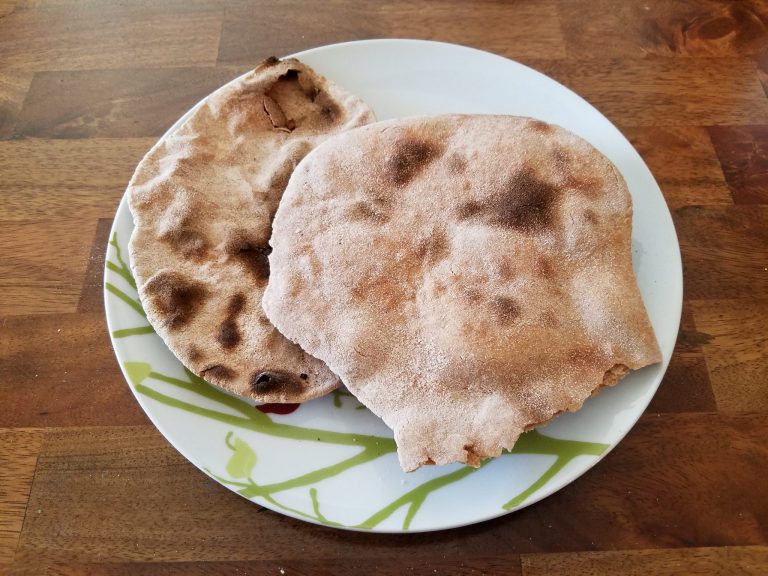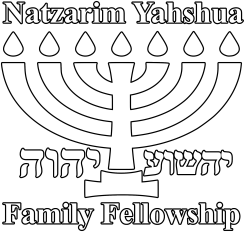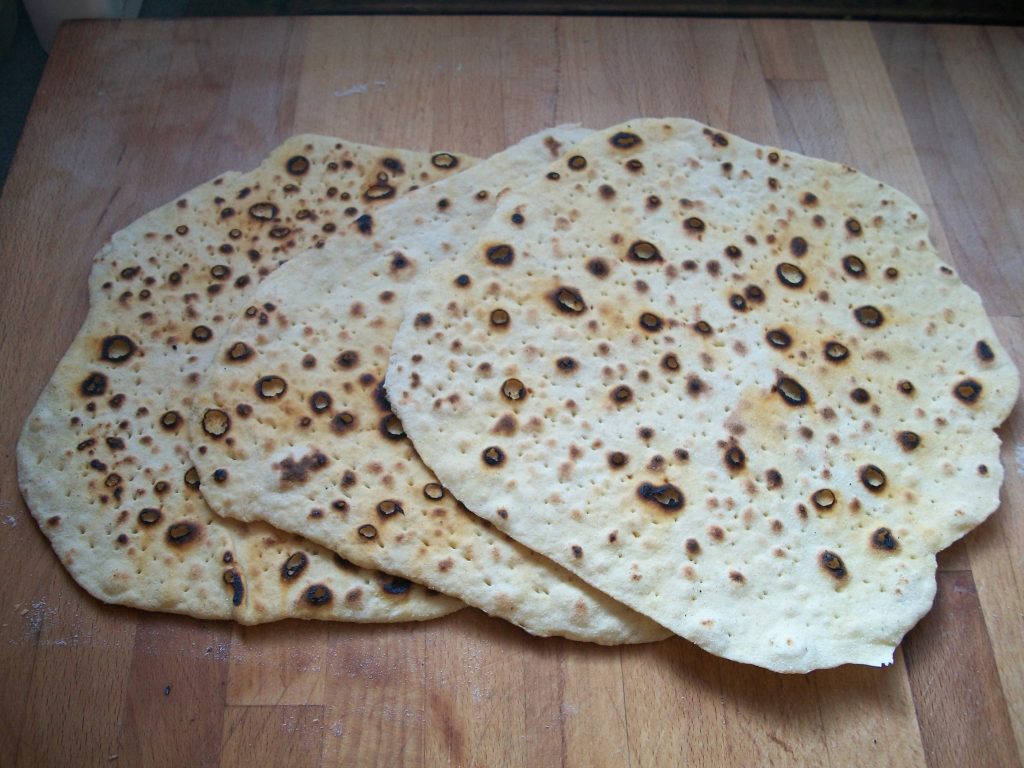
What is MATZAH?
MATZAH (maẓẓah; matzo; Heb. מַצָּה), unleavened bread made from one of five species of grain – wheat, barley, spelt, rye, and oats – mentioned in the Torah, and the only bread which is permitted for use during Passover. Matzah (pl. matzot) is the object of a specific commandment calling for matzah to be eaten on Passover because the children of Israel “baked the matzot of the dough which they had brought forth out of Egypt, for it was not leavened; because they were thrust out of Egypt and could not tarry” (Ex. 12:39) – the speed with which matzot are prepared identifies it with the bread made in the Bible, when there was no time to prepare ordinary bread (cf. Gen. 18:6; 19:3). Only grains capable of fermentation are valid for the manufacture of matzah, and such grains are therefore limited to the five species.
What if I Don’t Like Those Dry Crackers?
The large square cracker version of matzah is a relatively recent and not universal form of matzah. Since around the 1800’s AD Ashkenazi matzah has become a hard thin wafer in order to extend its shelf life. Before that it was closer to Sephardim Matzot, which is softer and thicker, made using a much more watered batter. This soft matzah does not have a long shelf life, and indeed, before the advent of freezers, Sephardim baked matzah daily during the feast.
Which of The Five Grains Was Traditionally used for Pesach?
In ancient Egypt and Israel, barley was the first grain harvest which corresponds to the first two feasts; Passover and First Fruits.
“And Pharaoh sent, and called for Moses and Aaron, and said unto them, I have sinned this time: Yahweh is righteous, and I and my people are wicked. Entreat Yahweh (for it is enough) that there be no more mighty thunderings and hail; and I will let you go, and ye shall stay no longer. And Moses said unto him, As soon as I am gone out of the city, I will spread abroad my hands unto Yahweh; and the thunder shall cease, neither shall there be any more hail; that thou mayest know how that the earth is Yahweh’s. But as for thee and thy servants, I know that ye will not yet fear Yahweh your Elohim. And the flax and the barley was smitten: for the barley was in the ear, and the flax was bolled. But the wheat and the rye were not smitten: for they were not grown up.”
Exodus 9:27-32
Barley does not contain a lot of gluten, which means that on its own it is not good for making bread, unless unleavened bread is made. The day after the first shabbat following Pesach, Barley Flour was presented as a first fruits of the harvest wave offering in the Temple. The timing of the exodus and Pesach with the barley harvest suggests that the grain used for Passover matzah may have traditionally been Barley.
Matzah is known as leḥem oni, “the bread of affliction” (Deut. 16:3). On this basis the Karaites still make matzah only from barley, which was used to make the poor man’s bread. The same phrase is used in the talmudic discussion of whether matzah made from flour mixed with wine, oil, honey, or eggs instead of water may be used on Passover. Although it is not regarded as fermenting if there is no admixture of water, matzah made from any such ingredient is often forbidden on the first night of Passover since it constitutes “matzah ashirah,” the “matzah of opulence,” in contrast to the “bread of affliction.” Generally, matzah ashirah was permitted on the first night of Passover only for the sick or the aged.
Some however have pointed out that since First Fruits, the offering of the first of the barley harvest in the Temple, doesn’t occur until after the first shabbat following Pesach, that it would have been forbidden to eat any of that season’s barley before that day. That would mean all grain used for Pesach would have to come from the storage of grain from the previous year, and they could use any of the five species of grain (wheat, barley, spelt, rye, and oats) that matzah was made from throughout the year. So if the Pesach matzah could be made of wheat, what types of wheat were used?
There were only two types of wheat in ancient Israel:
Emmer (Also known as Farro) wheat was the common wheat found in Egypt and Israel during biblical times, and could have been used by anyone.
For the Showbread that was to be used in the Temple, and ate by the Levites, The Torah says,
“If the oblation be for thanksgiving, they shall offer loaves without leaven tempered with oil, and unleavened wafers anointed with oil, and fine flour fried, and cakes tempered and mingled with oil.”
Leviticus 7:12
There was a very fine and expensive wheat used in ancient Israel called Einkorn wheat, it had a sweeter taste, and it was stone ground seven times, making it very light, and fluffy. The finest flour that could be presented to Yahweh.
In recent years, people with celiac – an intestinal disorder with a dangerous reaction to the gluten in wheat – have been able to fulfil the mitzvah with oat matzah made from a specific non-gluten strain of oats. Spelt matzah is also commercially available for people with medical needs.
I’ve Heard Something About an 18 Minute Time Limit, Why is That?
There is often yeast naturally in the air, and if grain is moist for over 18 minutes it might begin to puff up or become leavened, which goes against the commandment, and the spiritual meaning within the commandment. It therefore became tradition to not let the bread stay moist for longer than 18 minutes without being cooked, and therefore preventing any leavening of the bread.
The 18 minutes precisely tradition is of course modern, since precise clocks are modern, and therefore biblically one doesn’t exactly have to make the bread and cook it in less than 18 minutes, though making the bread quickly, without delay, is mentioned in the Bible,
“They baked unleavened cakes of the dough which they brought forth out of Egypt, for it was not leavened; because they were thrust out of Egypt, and could not delay, neither had they time to prepare food for the trip.”
Exodus 12:39
Therefore one should make it as quick as possible, so trying to make it within 18 minutes isn’t a bad goal.
Someone said I shouldn’t eat corn, rice, or beans, and called it Kitniyot, what’s that?
Kitniyot (Hebrew: קִטְנִיּוֹת, qitniyyot) is a Hebrew word meaning legumes. During the Passover holiday, however, the word kitniyot takes on a broader meaning to include grains and seeds such as rice, maize (American corn), sunflower seeds, sesame seeds, soybeans, peanuts, peas, and lentils, in addition to legumes.
The Torah only prohibits eating cHametz during Passover. cHametz is leaven made from the five grains: wheat, spelt, barley, oats, or rye.
Among Orthodox Ashkenazi and some Sephardic Jews, the custom (minhag) during Passover is to refrain from not only leavened forms of the five grains, but also kitniyot. Although all other Jewish traditions allow for the consumption of kitniyot during Passover.
The tradition of not eating kitniyot during Passover originated in early medieval France and Provence, and later flourished in high medieval Ashkenazi (Rhineland) Germany. The original reasons behind the custom of not eating kitniyot during Passover seem to have been that these items were normally stored in the same sacks as the five grains and people worried that they might become contaminated with cHametz. It is also possible that crop rotation would result in the forbidden cHametz grains growing in the same fields, and being mixed in with the kitniyot. Those concerned with these issues suggested that by avoiding eating kitniyot, people would be better able to avoid cHametz. Since halakha law is quite stringent about the prohibition against cHametz in the house during Passover, even in small amounts, a tradition developed to avoid these products altogether.
So the tradition of not eating kitniyot stems from no earlier than the 11th to 13th century in Europe, and not from biblical times or from Israel. In fact, Rabbi Mordechai Eliyahu states that Ashkenazim in Israel would eat fresh kitniyot on Pesach until the 1700s, when new Ashkenazi immigrants brought with them the custom not to eat fresh kitniyot.
Some Orthodox rabbis, such as David Bar-Hayim at ‘Beth HaWaad’ beth din of Machon Shilo and Conservative Rabbi David Golinkin of the Schechter Institute of Jewish Studies, have argued that the prohibition of kitniyot, while an appropriate precaution in medieval Eastern Europe where the Askenazi tradition began, should not be applied to modern United States or Israel. Likewise, The Committee on Jewish Law and Standards issued two responsa in December 2015 that said it is permissible to eat Kitniyot during Passover throughout the world. Torat Eretz Yisrael and Minhagei Eretz Yisrael have also stated, “Any Jew worldwide, regardless of origin, and despite the practice of their forefathers, may eat kitniyot on Passover, for it is a practice rejected as an unnecessary precaution by Halachic authorities as early as the time of its emergence.”
Recipe for Biblical Matzah
Biblical Matzah can be made “Kosher for Passover” even according to the strict rules of modern Halachic Kashrut, and can be used to fulfil the commandment of eating Matzah during the Passover Seder. This recipe has been recreated based on an ancient Hebrew recipe, and called Rekik Matzah, mentioned in Exodus 29:2 and Numbers 6:15.
unleavened (Matzah) bread, and unleavened (Matzah) loaves mixed with oil, and wafers (Rekikim) of Matzah, anointed with oil, of fine wheat flour, you should make them.
Exodus 29:2
וְלֶחֶם מַצּוֹת, וְחַלֹּת מַצֹּת בְּלוּלֹת בַּשֶּׁמֶן, וּרְקִיקֵי מַצּוֹת, מְשֻׁחִים בַּשָּׁמֶן, סֹלֶת חִטִּים, תַּעֲשֶׂה אֹתָם.
Ingredients
- 1 1/2 cups Flour (preferably stone ground, and either Emmer/Farro, Einkorn, or Barley)
- 1 tablespoon of Olive Oil (or more as needed)
- 1/2 cup Water, Room Temperature
Servings 3 Matzot
If one believes baking is what is called for:
- Oven Preheat Time 1 hour
- Prep Time 6 minutes
- Cook Time 3 minutes
Instructions
- Place a ceramic pizza stone on the top shelf of the oven, which is right below the top heating element. Turn the oven to broil (500°F). The Matzah must bake right next to the heating element or it will not fully bake quickly. Do not use the oven fans.
- Preheat the ceramic pizza stone in the oven for at least 1 hour. Do not start mixing the ingredients until the pizza stone is complete heated through.
- Place 1 1/2 cups of the flour into a large stainless steel bowl in which the dough will be kneaded.
- Set a timer for 18 minutes. This is the maximum allowable time that can pass between the mixing of the flour and water and all of the dough being fully baked, in order for the Matzah to be Kosher for Passover according to strict rules of modern Kashrut.
- Slowly add 1/2 cup of water to the flour in the bowl.
- Add 1 tablespoon of olive oil to the flour in the bowl.
- Quickly knead the dough with your hands by folding it over and over. The dough will form into a nice firm ball after 2-3 minutes of kneading.
- Sprinkle a large cutting board, which will be your rolling surface, with some flour to prevent sticking. Take the ball of dough from the bowl, place it onto the rolling surface and roll it with your hands into an even cylinder slightly shorter than the width of the cutting board.
- Cut the dough cylinder into 3 even pieces. Set 2 of the pieces aside on the cutting board and with your hands roll the remaining piece into a small ball.
- Take a rolling pin, rub some flour onto it with your hand, and begin rolling out the dough ball into a flat pancake.
- Repeat with the 2 other pieces of dough that you set aside, until you have 3 dough pancakes.
- Place the 3 pancakes onto the pizza stone. You might want to slide out the shelf with the pizza stone from the oven so it is easier to place the pancakes on it without getting burnt. Close the oven door and stay next to the oven. Do not walk away.
- After 1 minute open the oven door and check if the Matzah has started to become slightly brown and bubbles started forming on top of the dough. Once that happens flip all 3 Matzot onto the other side. Check the Matzah again after no more than 1 minute. The total baking process should take no longer than 2-3 minutes.
- Take out the Matzot from the oven and brush with a thin layer of olive oil.
- Place the Matzot on a plate to rest.
- The whole process must be completed in under 18 minutes in order to be compliant with strict laws of modern Kashrut. This is easily achievable if all steps are done efficiently. Enjoy.
If one believes frying is what is called for:
- Prep Time 6 minutes
- Cook Time 4 minutes per Matzot
Instructions
- Grease a large skillet with olive oil and heat over medium high heat.
- Set a timer for 18 minutes. This is the maximum allowable time that can pass between the mixing of the flour and water and all of the dough being fully cooked, in order for the Matzah to be Kosher for Passover according to strict rules of modern Kashrut.
- Place 1 1/2 cups of the flour into a large bowl in which the dough will be kneaded.
- Slowly add 1/2 cup of water to the flour in the bowl.
- Quickly knead the dough with your hands by folding it over and over. The dough will form into a nice firm ball after 2-3 minutes of kneading.
- Sprinkle a large cutting board, which will be your rolling surface, with some flour to prevent sticking. Take the ball of dough from the bowl, place it onto the rolling surface and roll it with your hands into an even cylinder slightly shorter than the width of the cutting board.
- Cut the dough cylinder into 3 even pieces. Set 2 of the pieces aside on the cutting board and with your hands roll the remaining piece into a small ball.
- Take a rolling pin, rub some flour onto it with your hand, and begin rolling out the dough ball into a flat pancake.
- Repeat with the 2 other pieces of dough that you set aside, until you have 3 dough pancakes.
- Place the bread pancakes into the skillet and lightly brown the bread until cooked, 2 minutes per side.
- Place the Matzot on a plate to rest.
- The whole process must be completed in under 18 minutes in order to be compliant with strict laws of modern Kashrut. This is easily achievable if all steps are done efficiently. Enjoy.



